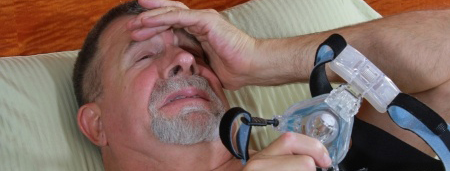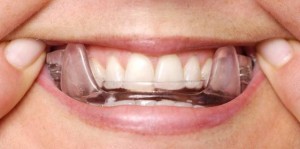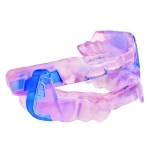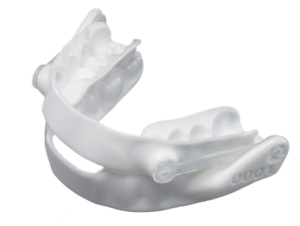Trouble with your CPAP? We have options for your sleep apnea treatment.

If you’re having problems tolerating your CPAP, find out more about Oral Appliance Therapy at Crossings Clinic.
Call 812-941-9000 to schedule your initial consultation or fill out the form at right. Start sleeping better!
Are you having any of the following problems while using your CPAP?
Oral Appliance Therapy for sleep apnea might be a better option for you!
Oral appliance therapy (OAT) is a treatment for obstructive sleep apnea and an effective alternative sleep apnea treatment to CPAP for those with mild to moderate sleep apnea. Administered by a dentist, oral appliance therapy uses a custom-fit “mouth guard-like” device (oral appliance) worn only during sleep to maintain an open, unobstructed airway.
Oral Appliances
 Oral appliances (OA) are a front-line treatment for patients with mild to moderate Obstructive Sleep Apnea (OSA) who prefer OAs to continuous positive airway pressure (CPAP), or who do not respond to CPAP, are not appropriate candidates for CPAP, or who fail treatment attempts with CPAP or treatment with behavioral measures such as weight loss or sleep position change. This small plastic device fits in the mouth during sleep like a sports mouth guard or orthodontic retainer. Oral appliances help prevent the collapse of the tongue and soft tissues in the back of the throat, keeping the airway open during sleep and promoting adequate air intake. Oral appliances may be used alone or in combination with other treatments for sleep-related breathing disorders, such as weight management, surgery or CPAP.
Oral appliances (OA) are a front-line treatment for patients with mild to moderate Obstructive Sleep Apnea (OSA) who prefer OAs to continuous positive airway pressure (CPAP), or who do not respond to CPAP, are not appropriate candidates for CPAP, or who fail treatment attempts with CPAP or treatment with behavioral measures such as weight loss or sleep position change. This small plastic device fits in the mouth during sleep like a sports mouth guard or orthodontic retainer. Oral appliances help prevent the collapse of the tongue and soft tissues in the back of the throat, keeping the airway open during sleep and promoting adequate air intake. Oral appliances may be used alone or in combination with other treatments for sleep-related breathing disorders, such as weight management, surgery or CPAP.
Standards of Care for Sleep Apnea Treatment
- Patients with primary snoring or mild OSA who do not respond to, or are not appropriate candidates for treatment with behavioral measures such as weight loss or sleep-position change.
- Patients with moderate to severe OSA should have an initial trial of nasal CPAP, due to greater effectiveness with the use of oral appliances.
- Patients with moderate to severe OSA who are intolerant of or refuse treatment with nasal CPAP. Oral appliances are also indicated for patients who refuse treatment, or are not candidates for tonsillectomy and adenoidectomy, cranofacial operations, or tracheostomy.
Oral Appliance Therapy
 Oral appliance therapy involves the selection, fitting and use of a specially designed oral appliance that maintains an open, unobstructed airway in the throat when worn during sleep. Custom-made oral appliances are proven to be more effective than over-the-counter devices, which are not recommended as a screening tool nor as a therapeutic option.
Oral appliance therapy involves the selection, fitting and use of a specially designed oral appliance that maintains an open, unobstructed airway in the throat when worn during sleep. Custom-made oral appliances are proven to be more effective than over-the-counter devices, which are not recommended as a screening tool nor as a therapeutic option.
Dentists with training in oral appliance therapy are familiar with the various designs of appliances and can help determine which is best suited for your specific needs. A board certified sleep medicine physician must first provide a diagnosis and recommend the most effective treatment approach. A dental sleep medicine specialist may then provide treatment and follow-up.
 The initial evaluation phase of oral appliance therapy can take several weeks or months to complete. This includes examination, evaluation to determine the most appropriate oral appliance, fitting, maximizing adaptation of the appliance, and the function.
The initial evaluation phase of oral appliance therapy can take several weeks or months to complete. This includes examination, evaluation to determine the most appropriate oral appliance, fitting, maximizing adaptation of the appliance, and the function.
Ongoing care, including short- and long-term follow-up is an essential step in the treatment of snoring and Obstructive Sleep Apnea with Oral Appliance Therapy. Follow-up care serves to assess the treatment of your sleep disorder, the condition of your appliance, your physical response to your appliance, and to ensure that it is comfortable and effective.
Advantages of Oral Appliance Therapy
- Oral appliances are comfortable and easy to wear. Most people find that it only takes a couple of weeks to become acclimated to wearing the appliance.
- Oral appliances are small and convenient making them easy to carry when traveling.
- Treatment with oral appliances is reversible and non-invasive.
How Oral Appliances Work
- Repositioning the lower jaw, tongue, soft palate and uvula
- Stabilizing the lower jaw and tongue
- Increasing the muscle tone of the tongue
Types of Oral Appliances
With so many different oral appliances available, selection of a specific appliance may appear somewhat overwhelming. Nearly all appliances fall into one of two categories. The diverse variety is simply a variation of a few major themes. Oral appliances can be classified by mode of action or design variation.
Tongue Retaining Appliances
Tongue retaining appliances hold the tongue in a forward position using a suction bulb. When the tongue is in a forward position, it serves to keep the back of the tongue from collapsing during sleep and obstructing the airway in the throat.
Mandibular Repositioning Appliances
Mandibular repositioning appliances reposition and maintain the lower jaw in a protruded position during sleep. The device serves to open the airway by indirectly pulling the tongue forward, stimulating activity of the muscles in the tongue and making it more rigid. The device also holds the lower jaw and other structures in a stable position to prevent the mouth from opening.
Other Treatment Options
There are three primary ways to treat snoring and sleep apnea, in addition to lifestyle changes such as good sleep hygiene, exercise and weight loss. The most common sleep apnea treatment is Continuous Positive Air Pressure. CPAP keeps your airway open by providing a steady stream of air through a tube connected to a mask that you wear as you sleep. Another option is surgery performed by an AADSM member trained as an oral and maxillofacial surgeon. A surgeon can prevent airway collapses by eliminating tissue in the soft palate, uvula and tongue. More complex surgical procedures can reposition the anatomic structure of your mouth and facial bones.
Used with permission of the American Academy of Dental Sleep Medicine, All Rights Reserved.
